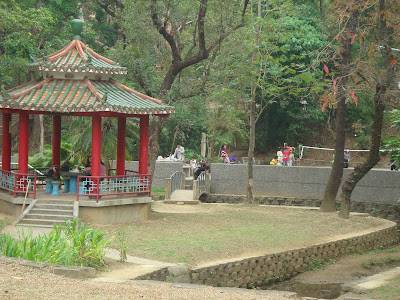In case you haven't heard of it, Tatajia is about 20km up the road from Alishan, and it's the usual starting point for hikers wanting to climb Yushan玉山. Most hikers camp out in a roadside car park, or pay 300元 to sleep in the bunk beds at the simple Dongpu Hostel東埔山莊. A few years ago though, I decided I would go my own way and pitch my tent up on one of Tatajia's hills. Howling winds and freezing temperatures made it a night I won't forget in a hurry. Any irritation or frustration I may have felt was soon dispelled however when the sun rose over the distant peaks. I cannot describe the splendor of that sight, the sky filled with constantly moving and changing color. I have traveled fairly widely, and I have seen many things, but sunrise that morning remains the most beautiful of them.
That was a few years ago, and I had to see if I could witness the spectacle again. So, ignoring the fact that we're still caught up in a bitterly cold winter, and the fact that Tatajia sits at an elevation of over 2500 meters, I decided I would ride my motorbike up there after work on Monday. "Don't you want to take your gloves?" my wife asked me before I left, "No, I'll be fine" I answered, but I wasn't. I was forced to buy some about halfway along my journey, but they were flimsy and woolen, and even after I put them on, I had to stop several times on my journey just to warm my hands up. By the time I got to Tatajia the pain in my fingers was ridiculous.
I set my alarm for 4am, and huddled down under 3 blankets in the Dongpu Hostel. I barely slept through the night, and when 4 o'clock came I was already dressed and heading out the door. The only problem then was that I didn't have a torch; it was probably lying at home next to my gloves. I made my way along the tree-lined paths by memory and the light of my old cellphone. I'll admit to being just the slightest bit scared.
I got to my destination, Mt. Linjhih麟趾山 and sat down to look at the stars. Tatajia is always popular with stargazers and the area even boasts its own observatory. There can't be many better places in Taiwan to come and look at the nighttime sky, and I was having a ball. The sight of a couple of shooting stars only added to the occasion.
Sunrise came at about 5.45. It was nice, but not really the thing of glory I had hoped for. With all that I'd been through to get there, I could have been forgiven for feeling disappointed, but that thought didn't even enter my head. Sunrise was nice, the night had been wonderful, and I still had a great morning in Tatajia to look forward to.


















 Nice as they are, these paths are not very long and even the most occasional of walkers will complete them with little real effort, so when you get to the Third Peak, look out for the sign marking the start of the Central Ridge Trail. This undulating walkway will lead you over and around Chingshuiyen’s valleys and peaks. The route’s many trees, a result of a 1950’s reforestation project, keep the area green and full of life. Pavilions again line the route, and they help give the place a communal and friendly atmosphere.
Nice as they are, these paths are not very long and even the most occasional of walkers will complete them with little real effort, so when you get to the Third Peak, look out for the sign marking the start of the Central Ridge Trail. This undulating walkway will lead you over and around Chingshuiyen’s valleys and peaks. The route’s many trees, a result of a 1950’s reforestation project, keep the area green and full of life. Pavilions again line the route, and they help give the place a communal and friendly atmosphere.
 From here it is possible to join up with Chingshuiyen’s other major hiking trail, The Ancient Trail of 18 Turns. To do so, turn left at the top of the steps and follow the path to a small seating area. It would appear that a farmer has tried to block the path at this point, but it is still fairly easy to climb over the fence and continue on your way.
From here it is possible to join up with Chingshuiyen’s other major hiking trail, The Ancient Trail of 18 Turns. To do so, turn left at the top of the steps and follow the path to a small seating area. It would appear that a farmer has tried to block the path at this point, but it is still fairly easy to climb over the fence and continue on your way.













 Getting down to the river’s edge is fairly easy, and from there you can walk along the sands of the riverbank, and see you the chasm in all its glory.
Getting down to the river’s edge is fairly easy, and from there you can walk along the sands of the riverbank, and see you the chasm in all its glory.
 It will take you about 3 hours to get to the gorge from Meishan, so it’s quite a long drive, but it’s also spectacular. The views of the Central Mountain Range are amongst the best that I have ever seen.
It will take you about 3 hours to get to the gorge from Meishan, so it’s quite a long drive, but it’s also spectacular. The views of the Central Mountain Range are amongst the best that I have ever seen.

















